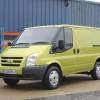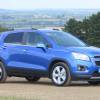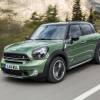
RAC sale – up to 33% off*
• Roadside cover from £5.29 a month†
• We get to most breakdowns in 60 mins or less
• Our patrols fix 4/5 breakdowns on the spot

BY JONATHAN CROUCH
Introduction
The Maverick was one Ford that British buyers never really took to their hearts. It was certainly late to the 4x4 party which started in the early Nineties. Perhaps they never forgave it for that.
More likely, however, a lack of image was to blame. Not even the most optimistic of Ford dealers could pretend that this was any kind of Range Rover. The sensible ones concentrated on its more hidden virtues; a rugged build, surprisingly good off road ability and a proven reliability record.
These attributes make it a good prospect as a secondhand buy. And despite the fact that relatively few were sold, prices are attractive on the used market.
Models
Models Covered:
(2.4 St Wagon 3dr, 5dr [base, GLX, Aspen, GLS] / 2.7TD St Wagon 3dr, 5dr [base, GLX, Aspen, GLS])
History
The Maverick was introduced in June 1993 as a joint venture with Nissan. In fact, to be more accurate, Nissan did all the work and Ford put up the cash. The feel of the car was therefore, not surprisingly, very Japanese, it didn't help in this respect that most of the interior fittings came straight from a Nissan Primera.
Right from the beginning, its identical twin, Nissan's Terrano II, outsold the Ford handsomely due to sharper pricing and a superior warranty. Both cars shared the same engines - either a 122bhp 2.4-litre petrol unit or a noisy and sluggish 100bhp 2.7-litre turbo diesel. There was the option of either three or five-door bodystyles and you could have either of two trim levels - base and GLX.
Two years later, in May 1995, the car came in for its first round of cosmetic prettying (a chrome bar was added to the front grille). The base model was re-named the Aspen and received a canvas spare wheel cover, electric windows and powered/heated door mirrors. The GLX had new seat material, an engine immobiliser and a leather-covered steering wheel. A driver's airbag was added to both in October 1995.
More significant improvements followed in June 1996 when the car was given a heavily chromed front end (supposed to engender 'an American look'). The 2.4-litre petrol engine was ecologically tweaked, while the 2.7TD got a welcome 25bhp power hike. The Maverick was gradually phased out of production during the first half of 1998 but there were a lot of cars in stock and you'll find a few on 99S plates.
What You Get
A decent family workhorse. The interior is just like that of any family hatchback. The trim quality is well up to standard and everything falls to hand easily. All the major bits and pieces of equipment are in evidence. On a GLS for example, you'll find alloy wheels, central locking, a powered sunroof, fog lamps, headlamp washers, electric front windows and heated mirrors.
Having said all that, there's little of the class you'd expect in an up-market family saloon. Hard plastic is everywhere. Still, it's practical. So is the reliability; Mavericks have a reputation for failing to break down - something many Vauxhall Frontera owners would kill for.
What You Pay
Please fill in the form here for an exact up-to-date information.
What to Look For
As with any used 4x4,check for signs of heavy off-road use. Few Mavericks will have done any more than mount a grass verge but you can never be too careful. Oil leaks and worn rear shock absorbers have been known. Drive the car around a corner in 4 wheel drive, the car may kick or hop. This is most likely to be a fault on the differential. To rectify the problem negotiate a discount of around £300.
Apparently, some TDs suffered from a vibration in the gearbox area which required a special clutch assembly. If you sense this to be a problem on the test drive, find out if it has been done. And on the subject of turbo diesels, try and stretch to the post-1996 car if you can. Otherwise, resign yourself to the slow lane.
Replacement Parts
(approx based on 1995 2.4) As you might expect from a Ford, parts are plentiful - but in the case of this model, they're not particularly cheap. A clutch assembly is around £215. Front brake pads are around £55, a rear exhaust about £55, a catalyst about £760 and an alternator around £230. A headlamp is about £80.
On the Road
"It doesn't sway about like most 4x4s and holds the road better. What's more, you can drive it like a car, even when towing a two-tonne trailer. The Maverick is quieter and much more refined than most of its contemporaries. As already mentioned, the original 2.7TD engine is rather slow but that apart, the Maverick is reasonably driver-friendly.
Though the car is obviously not designed as an out-and-out mud-plugger, it's quite competent enough off road to stay with its illustrious rivals over any ploughed field or icy slope.
Beyond that, you'd have to concede best to the more accomplished (and expensive) off roaders in the class. Having said that, what's the point in paying for all that extra mud-plugging ability if you're not going to use it?
What would be useful is the option to use 4WD over reasonably fast road use for peace of mind in slippery conditions. Still, there is a limited slip differential to keep the wheels from spinning too much.
Once you're on the dirt, you can reach for the second gearshift lever to bring full-time 4WD into play. At that point, you must choose between high and low ratios depending on the conditions and suddenly, particularly in turbo diesel form, the impressive low down pulling power of the engine comes into its own.
Overall
The Maverick makes far more sense secondhand than it ever did new. A reasonably priced one is well worth having.







